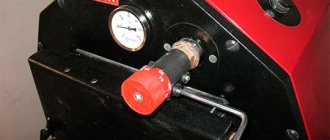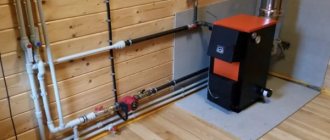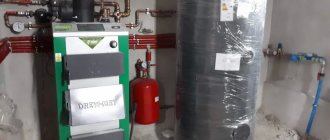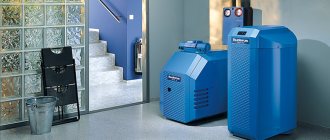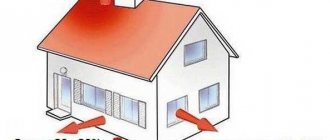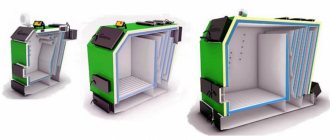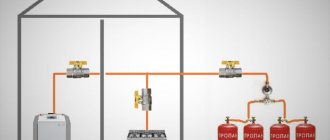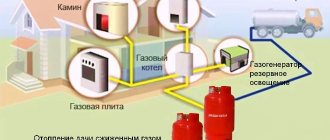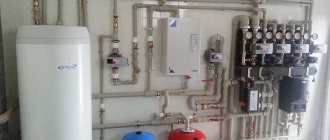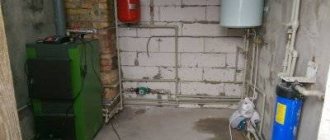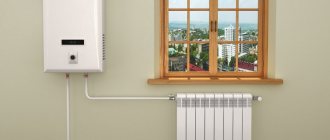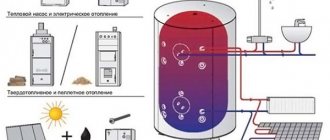Solid fuel boilers with high efficiency, designed for heating water, heating residential premises, buildings for various purposes, can operate efficiently and effectively under any conditions. Their performance directly depends on the design features and the method of fuel combustion.
The parameter that determines the quality of heat transfer during operation is efficiency (coefficient of performance). This indicator displays the ratio of the energy released during long-term combustion to the useful heat released, which provides the entire system. It is expressed as a percentage, and the value depends on the quality of the boiler’s operation: the better the unit functions, the higher the efficiency.
Solid fuel wood boilers
Wood-burning boilers are divided into three categories based on the principle of fuel combustion:
Solid fuel boilers of natural combustion
| In a solid fuel boiler with the usual natural process of fuel combustion, the entire stack of firewood burns at once . |
In traditional natural combustion boilers, the usual, natural process of fuel combustion occurs. Such boilers have a simple design, are relatively inexpensive, are less demanding on fuel quality and are not difficult to maintain.
The boiler power can be controlled by changing the intensity of fuel combustion, but in a limited range of 60-100%. To do this, closing the damper reduces the air supply to the boiler. This reduces not only the power, but also the efficiency of the boiler. The maximum efficiency of classical combustion boilers does not exceed 80%.
The biggest disadvantage is the short burning time
one load of fuel, usually no more than 4 hours.
Instability of solid fuels
Let's consider what is the instability of coal or wood as fuel. Let's start with coal.
There are countless different grades of coal offered on the market. Each brand differs in structure, chemical composition and moisture content. It can consist of both large pieces and small particles, and all of them can be mixed in different proportions. Accordingly, the calorific value of coal will be different each time. Accordingly, the efficiency and power of solid fuel coal will also be different.
If we talk about firewood, the situation here is exactly the same. Logs have different sizes, are stored at different air humidity, which means their ability to generate heat will be different. So, for example, if at a wood moisture content of 15%, its calorific value will be approximately 4.3 kWh per kilogram, then at 20% it will already be less than 4 kWh per kilogram. With higher humidity this figure will be even lower.
Naturally, with such variations, guaranteeing the exact efficiency and power of a solid fuel boiler equal to 90% is, to put it mildly, misleading.
Pyrolysis gas generator solid fuel boilers for long burning with wood
The operation of pyrolysis boilers is based on the principle of fuel gasification.
The boiler furnace is divided into two parts. In the upper chamber of the boiler (fuel loading chamber) the fuel smolders. Under the influence of high temperature and insufficient air for complete combustion, flammable gas is released from the wood, which is then burned in the lower chamber (combustion chamber).
This process increases the boiler efficiency to 85-90% and increases the combustion duration to 12 hours.
| In a pyrolysis boiler, the primary combustion of fuel occurs only in the lower layer of firewood . In the primary combustion zone, the fuel smolders, releasing flammable gases. The gases are mixed with secondary air and enter the main combustion chamber through the nozzle slot, where they burn. |
When gas burns, a very high temperature is created in the combustion chamber.
Therefore, the combustion chamber is lined with heat-resistant material. In pyrolysis boilers, fuel burns almost completely - little ash and soot are formed. For the boiler to operate, a forced air supply to the firebox is required. Pyrolysis boilers are quite complex and expensive devices. As a rule, boilers are equipped with a smoke exhauster and electronic control and monitoring devices.
Boilers require the mandatory use of firewood with a moisture content of no more than 20-25%.
When naturally dried in a woodpile, chopped firewood acquires the specified moisture content only after two years of storage under a canopy.
To increase the burning time of pyrolysis boilers, fuel of certain sizes is required, for example, the thickness of the log should not be less than 10 cm.
Boiler power control range 50-100% Boiler operation is disrupted at low load,
with power less than 30-50%. To heat the house in the off-season, another heat source is needed.
Pyrolysis boilers of the VERNER and ATMOS brands have good reviews from homeowners.
Solid fuel boilers with secondary air supplied to the firebox
(Pseudo pyrolysis boilers)
In conventional boilers with a natural combustion process, in order to regulate power, the air supply to the firebox is reduced. A lack of air for combustion, as in pyrolysis boilers, causes the appearance of flammable gases in the exhaust gases, which fly away uselessly into the chimney. Fuel consumption increases and boiler efficiency decreases.
| In a solid fuel boiler with secondary air supplied to the firebox, the usual natural process of fuel combustion occurs - the entire stack of firewood burns at once. The supply of secondary air to the upper part of the firebox promotes the combustion of combustible gases that appear when the air supply to the firebox is limited. The secondary air supply duct in the top door is shown with a blue arrow. |
To increase the efficiency of conventional solid fuel boilers, manufacturers have come up with the idea of additionally supplying secondary air to the upper part of the firebox
, and flammable gases burn in the firebox.
In such boilers, efficiency increases, but the burning time of the fuel load and other parameters remain the same as in traditional boilers.
However, some manufacturers and sellers also call such boilers pyrolysis. This is a marketing ploy - cheap pyrolysis boilers, go buy them. As they say, if you don't cheat, you won't sell.
In real pyrolysis boilers
the increase in combustion duration is due to the fact that the combustion process occurs only in the lower layer of firewood.
To prevent the entire fuel load from burning, the draft in the firebox is directed downward or away
from the combustion zone. Firewood smolders, and most of the heat is released as a result of combustion of gases.
In traditional boilers with secondary air supplied to the firebox
, gas combustion only slightly increases the heat supply, and only during the period when the boiler power is limited by covering the air supply.
The main amount of heat generated is provided by the natural combustion process of wood. The draft in the boiler furnace is directed upward
, so the entire fuel load burns.
There are boilers on sale (Russian, Chinese...) with a fake system for supplying secondary air to the firebox. When purchasing a boiler, they will show you the details of the system and tell you how it works, but in practice there will be no effect, since other conditions for gas combustion are not met.
Be wary if the seller claims that in his “pyrolysis” boiler you can burn fuel other than firewood, and afterburning gas in the furnace works on wood with high humidity. A lot of water vapor is released from wet fuel, which reduces the concentration and temperature of the exhaust gases and the gases do not burn.
The video shows an example of unfair advertising of a pseudo pyrolysis boiler as a pyrolysis
.
Natural combustion solid fuel boiler with secondary air supplied to the firebox.
What is efficiency
The efficiency factor of heating equipment is an indicator that is determined by the ratio of energy spent and useful heat entering the heating system for transportation to the room.
The efficiency percentage is calculated using the following formula:
q 1 + q 2 + q 3 + q 4 + q 5 = 100%
Explanation:
- q 1 is an indicator of the heat that was transferred to the coolant - water;
- q 2 - physical underburning - heat loss with exhaust gases;
- q 3 - chemical underburning - heat loss due to incomplete combustion of fuel;
- q 4 - heat loss during heat dissipation.
The efficiency of a solid fuel boiler will increase subject to optimized operation of the equipment.
High-quality installation, choice of raw materials, availability of ventilation and operating conditions significantly affect the efficiency indicator.
What does it depend on
Efficiency mainly depends on the loss of useful heat resulting from underburning of gases that are released during fuel combustion, as well as on the quality characteristics of the fuel and the amount of thermal energy released into the chimney.
The efficiency indicator depends on a number of factors:
- technical condition of heating equipment;
- load on the heating system;
- quality of fuel used by heating equipment.
Why is the efficiency higher in steel boilers?
In steel boilers, unlike cast iron ones, the efficiency will always be higher, since they require little energy input to heat a certain volume of water to the required temperature.
Steel is a less brittle material than cast iron, so in metal heating units it is possible to design a combustion chamber of a more complex geometric shape. Due to this, the heat exchange area increases, which leads to increased efficiency.
Steel units are characterized by fewer technological limitations. They allow you to increase efficiency by improving the design: adding convection channels, cooled grates, and increasing the reliability of the heat exchanger.
Due to high-quality insulation, steel boilers retain heat better. Two days after the unit is turned off, the temperature of its walls decreases by only 20 degrees.
Heating boiler of lower horizontal combustion
In a solid fuel boiler with a draft directed horizontally, the process of natural combustion of fuel occurs in the lower layer of firewood.
As can be seen from the figure above, in a boiler with horizontal combustion of fuel, combustion occurs near the grate, the resulting flue gases go into a vertical shell-and-tube heat exchanger, placed outside the stowage chamber and then into the chimney.
The heat generated during fuel combustion is absorbed by a water-cooled grate, furnace walls and a shell-and-tube heat exchanger. Gases with a low temperature necessary to create draft are emitted into the chimney.
In such a boiler design, the entire stack of firewood is not heated and is not blown through with hot flue gases. Only the bottom layer burns. This design allows you to increase the volume of the loading chamber, and ensures very long operation of the boiler on one load - with wood for up to 12 hours.
The boiler operates continuously, without stopping. Simply add fuel from above and remove ash from below while the boiler is running without stopping the combustion process.
The boiler is equipped with a damper located between the loading chamber and the chimney. Before opening the loading door, open the ignition valve. The draft through the open ignition valve prevents the boiler from smoking into the room through the loading chamber door when loading firewood.
Pay attention to the handle of the external cleaning mechanism above the blower door. Pulling the handle towards you activates the carriage for longitudinal cleaning of the grate. Cleaning can be carried out with the boiler running. When retracted, the carriage hides in the parking niche. External mechanical cleaning of the grate allows you to remove ash without stopping the boiler.
Operation on wet wood - the boiler can operate on wood with a humidity of up to 50%
Convenient top loading and easy maintenance - a convenient top loading door allows you to load the boiler with wood of the same size to the very top. Simple ramrod cleaning of the heat exchanger allows you to always maintain high boiler efficiency.
Backup electric heater - the boiler has a built-in heating element, which can be used to increase the maximum power of the boiler in the coldest time of the year or used as a backup heat source when the fuel runs out.
High efficiency - a water-cooled grate and an efficient shell-and-tube heat exchanger (the same as on industrial boilers) ensures high boiler efficiency over the entire operating power range.
Conclusions and useful video on the topic
The first video will help you understand how to clean the boiler heat exchanger, which will help to significantly increase its efficiency.
The following video will give you an opportunity to understand how to clean a gas burner in order to increase the efficiency of the boiler.
Experience shows that maximum efficiency from a boiler can be achieved with its systematic maintenance with timely cleaning of burners and heat exchanger from combustion products and dirt. And also with proper placement and use of radiators. In addition, only modern high-tech equipment can be highly efficient.
Have you noticed a discrepancy or want to supplement our material with useful recommendations for increasing the efficiency of the boiler? Leave yours, participate in the discussion and ask your questions to our experts - the feedback form is located below.
Heating solid fuel boilers using wood for long burning in the upper layer
| In a long-burning solid fuel boiler, the top layer of firewood burns |
The fuel in a top-burning boiler is laid in a thick layer in a high firebox and burns (smolders) from top to bottom, like a candle. The burning time of one load of firewood in the minimum mode reaches 30 hours.
The boiler operates with high efficiency up to 90% throughout the entire power control range. The boiler power is adjustable in a wide range from 10-100%.
The boilers do not have complex electronic control and monitoring systems. When working with wood, no electrical connection is required.
Top combustion boilers are less expensive than pyrolysis boilers. They require the mandatory use of firewood with a moisture content of no more than 20-30%.
They do not allow additional fuel loading; they operate only in the cycle: loading fuel - ignition - combustion - extinction - cleaning the boiler.
Top combustion boilers of the Liepsnele, Stropuva and Candle brands have proven themselves well.
The coolant fills the space between the inner and outer walls to the entire height of the cylindrical boiler body.
Combustion air is supplied directly to the combustion zone through a telescopic tube pos. 18 and air distributor pos. 11. Only the top layer of fuel, position 12, 10-20 cm thick, is constantly burning. As the fuel burns, the air distributor moves down, following the fuel.
Fuel is loaded through the door pos. 10. Exhaust gases are discharged into the chimney through the pipe pos. 7. The air supply is regulated by valve pos. 3, which is controlled by power regulator pos. 1. In chamber position 6, the combustion air supplied is preheated by the exhaust gases.
There are also more expensive models of boilers with combustion in the upper layer on sale. For example, a boiler from one of the manufacturers is equipped with a built-in heat exchanger for heating water in the hot water supply system.
Household products
⇆
The boiler has an electric air blower, which is controlled by an electronic system from a thermostat. As a result of changes in the amount of air, the power of the boiler during the combustion process changes depending on the temperature of the coolant.
The electronic system displays various indicators to monitor the operating mode of the boiler. The boiler has an indicator of the minimum amount of fuel in the firebox and sends a signal to the owner about this. The design of the boiler provides the possibility of additional fuel loading without stopping the combustion process.
Equipment manufacturers produce universal combi boilers
, which can burn fuel in two modes - with air supply either from below or from above. The cost of such boilers is naturally higher.
The best known manufacturers and models: characteristics and prices
Stropuva S15U
Stropuva (Stropuva) S15U with a power of 15 kW is a universal mine-type boiler that runs not only on coal, but also on wood, pellets and briquettes from any material. It is equipped with a bimetallic traction control, which eliminates the need to connect to the electrical network. Suitable for houses with an area of 100–120 m2.
Cost : 81,500–99,770 rubles.
Country of origin : Russia–Lithuania, STROPUVA LLC (STROPUVA).
Heiztechnik Q Alfa 15
Heiztechnik (Haytstechnik) Q Alfa 15 with a power of 15 kW - designed for heating a room with an area of 110–130 m2, burns coal, wood chips, various wood and briquettes. This Polish boiler is distinguished by a combination of cast iron grates and a body made of thick boiler steel (5 mm), which guarantees a long service life - up to 20 years.
Cost : 62,240–68,720 rubles.
Country of origin : Poland, HEIZTECHNIK LLC (HEIZTECHNIK).
Buderus Logano S181-15E
Buderus Logano S181-15E with a power of 15 kW is one of the best long-burning coal boilers for heating a private house with an area of 120–140 m2. The basic package includes water and gas temperature sensors, as well as a spacious hopper (240 l), thanks to which the device operates for 3-5 days in a row.
Cost : 218,000–250,640 rubles.
Country of origin : Germany, BOSCH LLC (BOSH THERMOTECHNIKA).
WEEK KO-60
WEEK KO-60 with a power of 60 kW is a highly efficient domestically produced model capable of heating a house of 200–250 m2 for 2–4 days using one bed of coal. Its microprocessor unit is not sensitive to power failures, and when turned off, the boiler simply goes out slowly (6–12 hours).
Cost : 115,900–130,500 rubles.
Country of origin : Russia (Kemerovo), TRIAY LLC.
TIS PRO 11
TIS (TIS) PRO 11 with a power of 11 kW is a compact unit that is well suited for heating a small private house, cottage or cottage of 80–100 m2. Air supply adjustment can be manual (using a bolt on the door) or automatic (using a mechanical thermostat) - your choice.
Cost : 64,100–67,200 rubles.
Country of origin : Belarus, BelKomin LLC TIS Group (TIS Group).
LIEPSNELE L20U
LIEPSNELE (Liepsnele) L20U with a power of 20 kW is a non-volatile boiler for a house of 150–180 m2, has a capacious loading chamber (320 l), which ensures the burning duration of one load of up to 6–7 days. It is practically “omnivorous”: it can be heated with coal, wood, sawdust, shavings, pellets and even peat.
Cost : 85,400–90,560 rubles.
Country of origin : Lithuania, LLC "VAKARO RASA" (VAKARO RASA).
Automatic solid fuel boilers
Automatic solid fuel boilers are available for sale. It would be more correct to call them semi-automatic, since the boiler still requires certain actions from a person periodically, albeit not every day.
You can get acquainted with the design and operating principle of an automatic solid fuel boiler if you watch this video clip:
The fuel for an automatic boiler can be granulated coal with a fraction of 5 - 25 mm. or wood pellets - pellets, as well as pellets from other combustible materials - peat and waste of plant and animal origin.
The need to use only granular fuel
for combustion in automatic boilers, causes certain difficulties for home owners. The cost of such fuel on the market is noticeably higher than conventional chopped wood or coal.
In automatic boilers, manufacturers often provide the possibility of replacing the burner for granular fuel with another burner - for gas or liquid fuel. Instead of a burner, grates can be installed. In this option, the boiler turns into a regular wood-burning boiler.
Granulated fuel is usually sold in bags. Fuel is easily and dust-free loaded into the boiler hopper. One loading of the bunker is enough for 3 - 10 days of boiler operation.
After ignition at the beginning of the heating season, combustion in the automatic boiler occurs continuously
. The automatic boiler can operate in two modes:
- Active combustion mode
, in which the boiler power can be in the range of 10 - 100% of the nominal. - Combustion support mode,
when the boiler power is selected to ensure the coolant temperature in the boiler circuit is about 55 degrees C. The automatic controller switches the boiler to support mode when there is no heat extraction from the heating circuit. This mode is necessary to protect the boiler from low-temperature corrosion (see below for more details), and also ensures that the boiler is always ready to resume active combustion.
During boiler operation it is necessary:
- Monitor the filling of the bunker and load fuel into the bunker once every 3 - 7 days.
- Remove ash from the removable ash drawer every 2 to 4 days.
- Once a week, clean the internal surfaces of the boiler from deposits with a special tool.
- Every year, before the start of the heating season, clean and check the serviceability of the boiler chimney.
Take a break
Successful and progressive companies create relaxation areas for employees where they can play sports, have fun with games, or simply relax in a corner with beautiful plants, a waterfall or an aquarium. How will this help mobilize brain activity? Switching from the task at hand to another activity that does not require a thought process helps you find a better solution faster. You are resting, but the subconscious is actively working on the problem. The ideal solution “pops up” unexpectedly and seems to be born on its own. If you feel that you are unable to make reasonable decisions and are marking time, take a break. Even a short rest will allow you to start more productive work
How to choose the power of a solid fuel boiler
A solid fuel boiler must be selected so that its rated heating power corresponds to the heat losses of the heated object.
Choosing a boiler with a rated power that is too high leads to the fact that the boiler operates in a mode of significant power limitation most of the time. And this, in turn, leads to a decrease in efficiency (increased fuel consumption), increased formation of deposits (soot, tar), accelerated corrosion of the boiler and chimney. The risk of overheating of the coolant in the boiler increases. The cost of boilers increases as power increases.
Therefore, you should not buy a boiler with significantly higher power
than heat losses at home.
True, when selecting a boiler with a large power reserve, the burning time of one load of fuel increases - there is more firewood in the firebox. But, this advantage can only be profitably realized in a heating system with a heat accumulator .
Accurately calculating the heat losses of a house and the power of a heating boiler is quite a complex task, the solution of which is best entrusted to specialist designers. Managers of a company that sells boilers will most likely advise you to choose a boiler with excess power - this is beneficial for them.
approximate power of the boiler for heating a house is selected based on generally accepted values of specific power per 10 m2 of heated area according to climatic zones:
- For the southern regions of Russia: 0.7 - 0.9 kW/10m2.
- For the middle zone - 1.2 - 1.5 kW/10m2.
- For northern regions - 1.5 - 2 kW/10m2.
For example, for the Moscow region, in a house with a heated area of 150 m2, a boiler with a capacity of 150 m2 x 1.2 kW/10 m2 = 18 kW should be installed.
For a house built in compliance with modern energy saving requirements, the smaller of the specified values is used for calculations.
It is recommended to increase the boiler power by approximately 30% when operating the boiler with a buffer tank - a heat accumulator. A power reserve is also necessary if the boiler is used in a hot water supply system.
It should also be taken into account that the heat capacity of non-freezing liquids is 20% lower than that of water. When used as a coolant, the boiler power may drop by 10 - 15% of the nominal value.
A water heating system with natural circulation of coolant is recommended for use in houses with a heated area of no more than 100 m2. In larger houses or in heating systems with heated floors, forced circulation of the coolant is used with the installation of circulation pumps.
Buy solid fuel boiler
Solid fuel heating boiler wood
⇆
Tips for choosing
The choice of radiator depends on the heating system installed in the house. For an autonomous design, it is recommended to use batteries made of cast iron, steel and aluminum. Such products can easily withstand circuit pressure.
In apartment buildings with central heating, cast iron or bimetallic products are installed. Such radiators will withstand increased circuit pressure and will last for many years.
The main criterion for choosing a battery is heat transfer. The temperature inside the room depends on this. Aluminum, steel and cast iron products have proven themselves well, so they are preferred by most users.
Protection of solid fuel boiler from overheating
In a solid fuel boiler, the burning fuel, and the boiler itself, have a fairly large mass. Therefore, the process of heat release in the boiler has great inertia. The combustion of fuel and heating of water in a solid fuel boiler cannot be stopped instantly by stopping the fuel supply, as is done in a gas boiler.
Solid fuel boilers, more than others, are prone to overheating of the coolant - boiling of water if heat extraction is lost, for example, when the circulation of water in the heating system suddenly stops, or more heat is released in the boiler than is consumed.
Boiling water in the boiler leads to an increase in temperature and pressure in the heating system with all serious consequences - destruction of heating system equipment, injury to people, damage to property.
Modern closed heating systems with a solid fuel boiler are especially prone to overheating, since they contain a relatively small volume of coolant.
Heating systems usually use polymer pipes, manifold control and distribution units, various taps, valves and other fittings. Most elements of the heating system are very sensitive to overheating of the coolant and pressure surges caused by boiling water in the system.
A solid fuel boiler in a heating system must have protection against overheating of the coolant . To protect a solid fuel boiler from overheating in a closed heating system that is not connected to the atmosphere, two steps must be taken:
- Shut off the combustion air supply to the boiler furnace to reduce the intensity of fuel combustion as quickly as possible.
- Ensure cooling of the coolant at the boiler outlet and prevent the water temperature from rising to a boil. Cooling must occur until the heat generation is reduced to a level at which boiling of water is no longer possible.
Let's look at how to protect the boiler from overheating, using the heating diagram shown below as an example.
Connection diagram for a solid fuel boiler to a closed heating system
| Scheme of a closed heating system with a solid fuel boiler. 1 - boiler safety group (safety valve, automatic air vent, pressure gauge); 2 — tank with a supply of water for cooling the coolant when the boiler overheats; 3 - float shut-off valve; 4 - thermal valve; 5 - connection group for expansion membrane tank; 6 — coolant circulation unit and boiler protection from low-temperature corrosion (with a pump and three-way valve); 7 - heat exchanger for protection against overheating. |
Boiler overheating protection works as follows.
When the coolant temperature rises above 95 degrees, the thermostat on the boiler closes the air supply damper into the combustion chamber of the boiler.
Thermal valve pos. 4 opens the supply of cold water from the tank pos. 2 to the heat exchanger pos. 7. Cold water flowing through the heat exchanger cools the coolant at the outlet of the boiler, preventing it from boiling.
A supply of water in tank pos. 2 is necessary in case there is no water in the water supply, for example, during a power outage. Often a common storage tank is installed in the water supply system of a house. Then water for cooling the boiler is taken from this tank.
A heat exchanger to protect the boiler from overheating and cooling of the coolant, pos. 7, and a thermal valve, pos. 4, are usually built into the boiler body by boiler manufacturers. This has become standard equipment for boilers designed for closed heating systems.
In heating systems with a solid fuel boiler (except for systems with a buffer tank), thermostatic valves and other automatic devices that reduce heat extraction cannot be installed on heating devices (radiators) . Automation can reduce heat consumption during periods of intense fuel combustion in the boiler, and this can trigger overheating protection.
Another way to protect a solid fuel boiler from overheating is described in the article:
Read: Buffer tank - protecting a solid fuel boiler from overheating .
Continued: go to next page 2:
Read page: Page 1, Page 2
More articles on this topic
- Load-bearing, self-supporting and non-load-bearing walls - what's the difference!?
- Sound insulation - sound insulation of a house, apartment
- Norms and rules for planning a private house, cottage
- Wooden floor on joists on the first floor of a private house
- Heating costs and heat transfer resistance in a private house
- Heating scheme with solid fuel boiler and heat storage tank
- Magnesium or aluminum anode for water heater
- How to make a house warm. Energy saving house
Radiator installation
To maximize efficiency, you need to install radiators so as to heat the room as much as possible. Heat loss should be minimal. The window sill should cover the top of the battery 2/3. The distance from the top of the section to the window sill is 1 meter, from the floor to the radiator – 1m 20 cm. From the wall to the panel on the radiator (rear part) – 2 cm. Heat flows will partially linger near the window sill, heat the wall, and reduce heat loss through the window.
The coolant also needs to be selected correctly. Antifreeze has a low energy content. Therefore, it is better to fill the pipes with distilled water. You can change the burner from an old model to a new one to improve safety and gas consumption. Systematic pipe cleaning will increase efficiency. Several methods are used for this: chemical, hydraulic or a combination. It is necessary to install mirror screens behind the batteries. Even regular dust removal will improve heat transfer.
